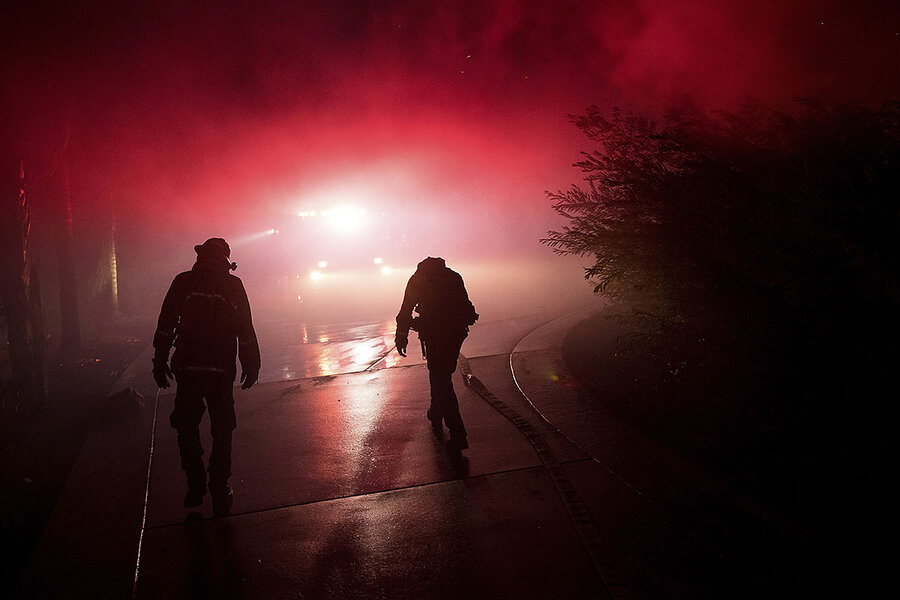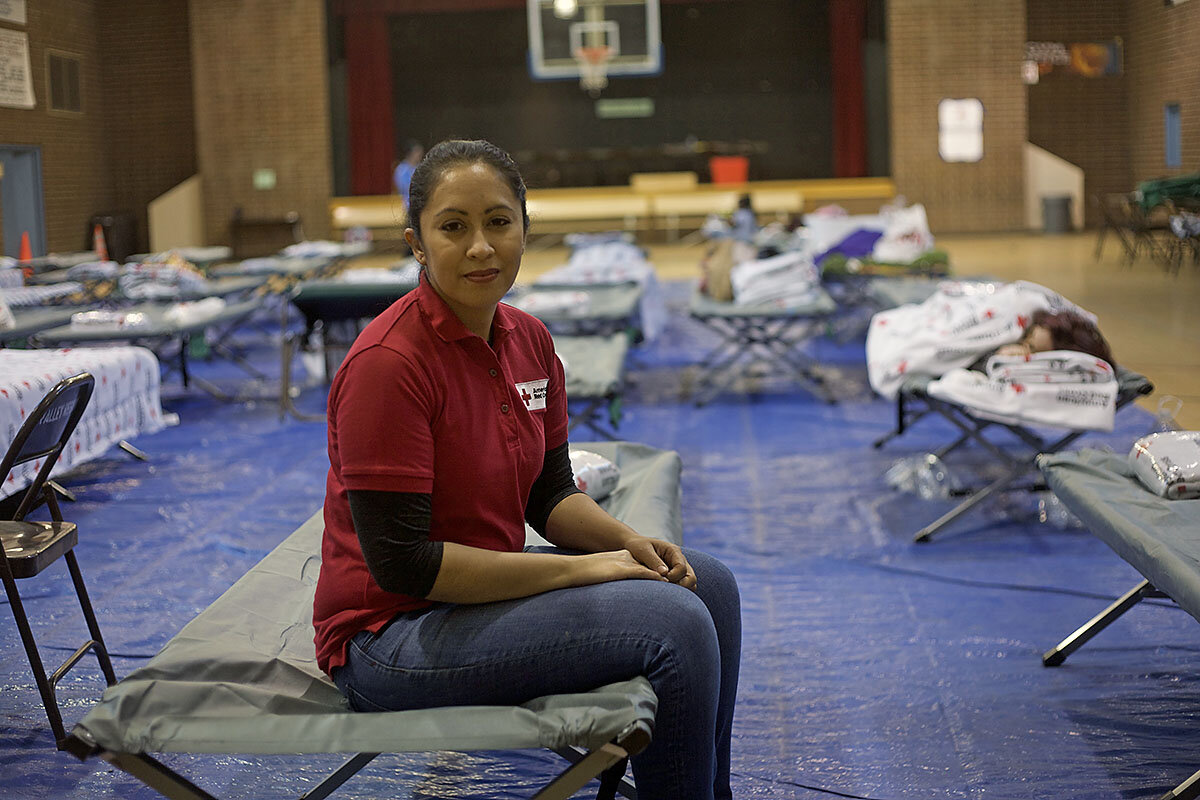Skirball fire underscores calls for collaborative wildfire management
Loading...
| Los Angeles
On the morning of Dec. 6, Laura Lenk woke to the sound of sirens.
She had parked for the night at a lot at the Leo Baeck Temple, a synagogue tucked into the hills of northwest Los Angeles that provides free, safe parking for people who live in their vehicles. As fire trucks whizzed by early that morning, Ms. Lenk thought there must have been an accident on the nearby 405 freeway.
Then she pulled down the sunshade she’d placed on her windshield and saw the flames.
“It looked like the whole hillside was on fire,” Lenk says, sitting at the evacuation center in Arleta, Calif., where she ended up seeking shelter. “It seemed like it was right in my face. I literally threw my cat in the carrier and drove out of there.”
The Skirball fire, which Lenk narrowly escaped, started around 5 a.m. Wednesday and burned through 475 acres in the hills near Bel Air. The blaze destroyed four homes, damaged 11 others, and forced 46,000 residents to evacuate.
It was one of six major wildfires to ignite across Southern California this week, burning 141,000 acres and causing at least 190,000 people to have to evacuate their homes, according to Cal Fire officials.
- The Thomas fire burned 115,000 acres across Ventura County, just north of Los Angeles.
- The Rye fire torched about 7,000 acres in Santa Clarita
- The Creek fire spread through 12,600 acres in the Angeles National Forest and drove 100,000 people out of their homes.
- Two new fires Thursday, the Lilac fire near San Diego and the Liberty fire, complicated efforts by some 5,700 firefighters to contain the blazes amid Santa Ana winds.
The wildfires mark a destructive end to a year already considered the state’s worst fire season on record. They’re also a dramatic demonstration of what scientists and fire practitioners in the region have been saying for years: that long-term trends tied to climate change coupled with increased populations in high fire risk areas could lead to more extreme fire events that affect more people than ever. If communities are to survive – and thrive – in these new conditions, they say, government, practitioners, and residents are all going to have to reexamine what it means to live with fire.
“We have to work better to maximize our resources and create the best working agreements we can,” says former Ventura County fire chief Bob Roper, who helped develop programs around fire prevention and response across the region and nationwide. “But the public has to be a key partner in whatever we do.”
Rapid response
A day after the Creek fire started burning, the Branford Recreation Center in Arleta was a picture of competence: Volunteers set up sleep stations and helped families settle in as the work day came to a close. Rows of cots lined the gymnasium floor. Supplies sat on tables and filled boxes. In some ways the scene epitomized the maturity of the crisis response system in a disaster-prone, dense urban area like Los Angeles.
“This is the first time I’ve had to evacuate. I really dislike it ... but I slept good last night,” says Collin Chamberlain, a Korean war veteran who made for Branford after having to leave his home in Sunland on Tuesday. “These blankets are excellent.”
“We have diapers, milk, toys, food,” adds Nancy Rodriguez, a former Red Cross staffer turned volunteer. “There’s a massive warehouse in L.A. where there are thousands of cots and blankets.”
The California Department of Forestry and Fire Protection, or Cal Fire, is also well equipped. The agency has about 5,000 professional and volunteer firefighters on staff and more than 50 firefighting aircraft in its fleet. The state’s various agencies and departments have also signed an agreement that ensures everyone participates in rescue, relief, evacuation, and recovery efforts in the event of a disaster.
But resources alone aren’t enough to combat California’s increasingly nasty wildfires, says Cal Fire information officer Scott McLean.
'Like a blowtorch'
Extreme climate conditions, including five years of drought, has led to an excess of dry vegetation that has made parts of the state more flammable than ever. In Southern California’s case, the yearly Santa Ana winds that blow in from the Great Basin in Nevada have gusted through the coast at speeds of up to 80 miles per hour for nearly a week. Those winds, combined with the lack of rainfall in the region, make for erratic fire behavior that’s difficult to contain, Mr. McLean says.
“We’re dealing with fire that’s like a blowtorch,” he says.
It doesn’t help that, as cities grow denser and the cost of living rises, more people are moving into fire-prone areas. Heath Hockenberry, fire weather program manager at the National Weather Service, points out that places like Idaho and Montana are also seeing longer concentrations of high-intensity fires.
“But those are communities of about 50, 100 people, as opposed to millions in California,” Mr. Hockenberry says. “It is a population correlation that really brings the conversation up nationally.”
Confronting a new reality together
Fire practitioners, nonprofits, and government agencies have begun to recognize this new reality. Through the early 2000s, Congress authored laws meant to catalyze fire preparedness efforts across the country. In 2013, practitioners in the West founded the Fire Adapted Communities Learning Network, which connected communities that had for years been working to address local fire issues on their own. A year later, the Obama administration released a national cohesive strategy that called on stakeholders from all levels of government and the community to address wildland fires.
There have also been efforts to more efficiently disseminate information before, during, and after fire events. Early Tuesday morning, for instance, hundreds of thousands of Ventura County residents received an emergency alert on their phones warning them that the Thomas fire was spreading. “I think that’s a dissemination victory,” Hockenberry says. “It definitely got the word out and superseded all jurisdictions.”
He adds that researchers are working to improve their ability to predict fires, especially in densely populated areas. “Hurricane warnings are designed with people and structures in mind,” he says. “We’re beginning to look at those societal impacts with fire in mind, as well.”
Still, the success of any strategy relies on continuous public participation, experts say. That means building homes that are up to code, keeping driveways and gutters free of flammable debris like dry leaves and firewood, and paying attention to changes in weather conditions.
“If you live in the wildland area, you have a personal responsibility to be part of the solution,” says Mr. Roper, the former fire chief.







